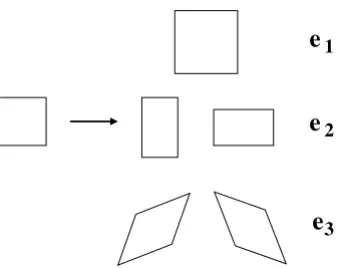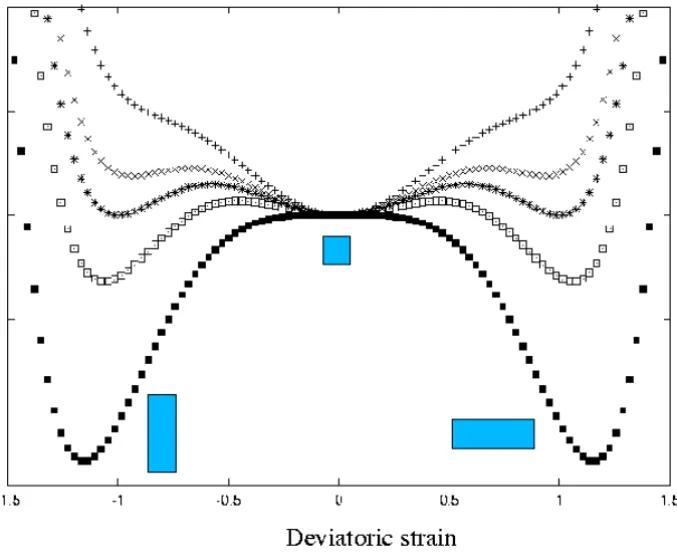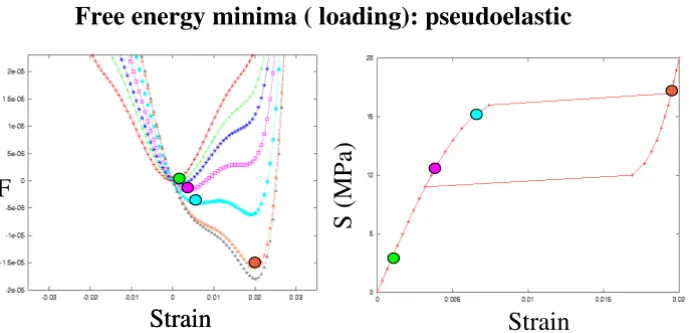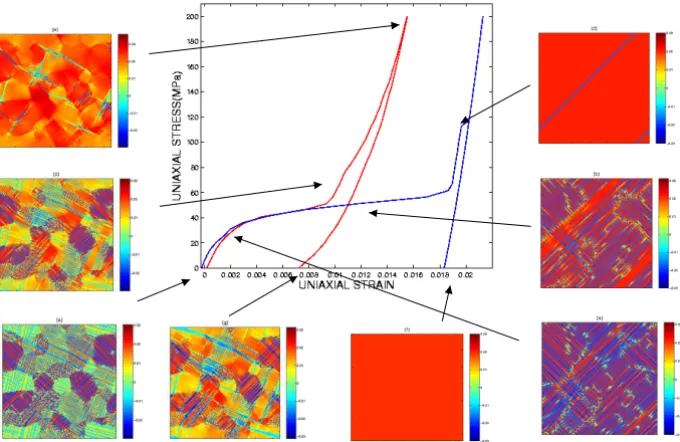www.scielo.br/cam
Modeling solid-solid phase transformations:
from single crystal to polycrystal behavior
R.C. ALBERS, R. AHLUWALIA, T. LOOKMAN and A. SAXENA
Theoretical Division, Los Alamos National Lab, Los Alamos, New Mexico 87545 USA E-mails: rca@lanl.gov / rajeev@lanl.gov / txl@lanl.gov / avadh@lanl.gov
Abstract. We introduce a framework for modeling elastic properties of shape memory alloy
polycrystals by coupling orientational degrees of freedom with elastic strains. Our method allows us to span the length scales from single crystal to that appropriate to obtain polycrystal properties.
The single crystal free energy coefficients can be determined from microscopic calculations (such as electronic structure and molecular dynamics) and/or available experimental structural, phonon and thermodynamic data. We simulate the microstructure and determine the stress-strain response
of the polycrystal and compare it with that of a single crystal. For FePd parameters we find that the recoverable strain for a polycrystal is∼ 40% of that for a single crystal. The polycrystal information can, in principle, serve as input to the engineering scale of calculation, where the
finite element method is appropriate.
Mathematical subject classification: 74B20, 74N10, 74N15.
Key words: martensites, shape memory alloys, polycrystals, Landau theory PACS: 81.30.Kf,
64.70.Kb, 61.72.Mm.
1 Introduction
There are many types of solid-solid transformations that occur in nature. A par-ticular class of these transformations is known as martensitic transformations. Martensites are characterized by diffusionless, first-order structural phase transi-tions between different crystalline phases. These solid-solid transformatransi-tions are important as crystal symmetry-changing phase transitions as well as for their role in inducing technologically useful materials properties. There is a related class of materials known as ferroelastics. Ferroelasticity is defined by the existence
of two or more stable deformation states of a crystal that correspond to different arrangements of the atoms, but are structurally identical [1,2]. In addition, these deformation states are degenerate in energy in the absence of mechanical stress (e.g., there are three deformations of a tetragonal crystal resulting from a transi-tion from a cubic crystal such as in FePd). Salient features of ferroelastic crystals include mechanical hysteresis and mechanically switchable domain patterns.
Since the ferroelastic transition (induced by either temperature change or ap-plication of stress) is normally weakly first order, or second order, it can be de-scribed to a good approximation by the Landau theory with spontaneous strain or deviation of a given ferroelastic deformation state from the parent phase as the order parameter. The strain can be coupled to intra-unit cell (shuffle) modes or other fields such as electric polarization and magnetic moment (e.g., in magnetic martensites) and thus the crystal can have more than one transition. We note that the Landau theory is a mesoscale description at a length scale on the order of one (or a few) unit cell(s). To include the inhomogeneous variation of the order parameter strain, such as across a domain wall or twin boundary, the square of the strain gradient is included in the free energy to account for the energy cost for creating a domain wall. This is refered to as the Ginzburg term and the resultant description is called the Ginzburg-Landau free energy.
is intimately involved in shape-memory [3], and related phenomena.
The multiscale mechanism by which local perturbations (such as defects or localized stress) can have large-scale effects on elastic patterning isanisotropic long-range strain-strain coupling. Thislong-range coupling arises because of elastic compatibility constraints on the allowed unit celldeformations (in the absence of bond-breaking) and is therefore indeed inherited from verylocal, atomic scale (i.e., microscopic), symmetries. We have recently developed mod-els of elasticity and solid-solid phase transformations at the mesoscopic (“coarse-grained”) level of a nonlinear Ginzburg-Landau description for single crystals, including the compatibility constraint self-consistently [8]. This allows a de-scription of systematic twinning, tweed and other fine-scale hierarchical struc-tures,i.e. to connect intrinsic multiscale phenomena in solid state physics and materials science. Our model can predict multiscale elastic textures and their consequences in a unified manner as demonstrated below through simulations.
Most commercial applications of shape memory alloys [3] (such as NiTi, FePd and CuZnAl) make use of polycrystalline specimens and therefore it is important to study and compare the mechanical response of polycrystals to that of single crystals. The problem of finding the effective properties of martensitic polycrys-tals has been studied by analytical methods [9-11] and finite element simulations [12]. However, these methods do not account for the complex polycrystal geom-etry and also do not incorporate the long-range elastic interactions between the grains. Continuum simulations that span a range of length scales are good candi-dates to describe these issues. Recently, phase-field micro-elasticity models that employ static grains created by the Voronoi construction have been studied [13]. Nevertheless, it is important to regard the grain orientation as a thermodynamic variable since the orientation distribution (texture) of a polycrystal can change due to an applied load.
elastic strains are coupled to a phase-field model through an orientation field that is determined from a multi-component order parameter describing the crystal orientations. Due to this coupling, the strains as well as the grain orientations can change under an external load. Here we determine the stress-strain (consti-tutive) response within the coupled phase-field-elasticity model. The polycrystal response serves as a natural input for the next higher length scale, namely for the finite element methods.
2 The Landau model for a single crystal
The true degrees of freedom in a continuum elastic medium (such as described by Ginzburg-Landau models) are contained in the displacement field,u(r), even though it is the strain fields,ǫij, which appear in the free energy [as order
param-eter (OP) in the anharmonic part and as non-OP in the harmonic part]. Instead of treating the strains as independent fields, one must assume that they correspond to a physical displacement field, i.e., that they are derivatives of a single contin-uous function. This is achieved by requiring that they satisfy a set of nontrivial compatibility relations concisely expressed as a differential relation between the strain components. Ignoring the geometrical compatibility constraint and min-imizing the free energy directly would lead to the incorrect result that non-OP strain components are identically zero, and the OP strain trivially responds to perturbations, e.g. stress and local disorder, which is certainly not true. One can explicitly account for the compatibility constraint by appending it to the free energy via a Lagrange multiplier. Then the non-OP strain components can be expressed in terms of OP strain components by minimizing the free energy. This procedure results in an anisotropic, long-range interaction between the OP strain(s) as shown below.
In d-dimensions (d = 1,2,3) the displacement field has d independent components at any pointx, whereas a symmetric strain tensor nominally has
e
e
e
13 2
Figure 1 – The three deformations of a square lattice and associated strain tensor com-ponents:e1(dilatation),e2(deviatoric) ande3(shear).
strain tensor in two (or three) dimension are defined by
ǫij =
1 2
ui,j +uj,i+uk,iuk,j
, (1)
whereui,j =∂ui/∂xj are the derivatives of the displacement vector with respect
to material coordinatesxj in a Cartesian frame. The last term in the above
equa-tion (with summaequa-tion overkimplied) refers to “geometrical non-linearity” in strain and is important for finite strain deformations and lattice rotation. How-ever, in most martensitic transitions of interest the strain is usually less than 10% and the last term can be neglected. In this approximation of geometrically linear elasticity the compatibility condition (in any dimension) is compactly written as [17-19]∇ ×(∇ ×↔ǫ )T = 0, whereT denotes transpose. The zero on the
right hand side indicates no source terms such as arising from dislocations or disclinations. The “incompatibility” due to such lattice topological defects can be included by using the Burgers vector (density) on the right hand side of the equation.
In one dimension there is no compatibility constraint. In two dimensions there is only one compatibility equation:
ǫxx,yy+ǫyy,xx =2ǫxy,xy. (2)
OP in a structural transition, symmetry methods come very handy (particularly in three dimensions). Strain corresponds to the centerk=0 of the reciprocal lattice unit cell (i.e. in Fourier space). That is, it is a variable which does not break translation symmetry of the lattice. For a square lattice we find three symmetry-adapted strains [8,20], namely dilatation(e1), deviatoric or rectangular(e2)and shear(e3)strains defined as:
e1= 1
√
2 (ǫxx+ǫyy), (3a)
e2= 1
√
2 (ǫxx−ǫyy), (3b)
e3= ǫxy, (3c)
which are depicted in Fig. 1.
The compatibility condition in these variables is
∇2e1(r)−
√
8∇x∇ye3(r)=
∇x2− ∇
2
y
e2(r). (4a)
In Fourier space, with periodic boundary conditions, it reads
k2e1(k)−
√
8kxkye3(k)=(k2x−k
2
y)e2(k), (4b)
wherek=(kx, ky)is the wavevector. The free energy functional for the square
to rectangle transition is given by
F =
drfelast ic+fload
, (5)
where
felast ic=
A1 2 e 2 1+ A3 2 e 2
3+flocal(e2)+
K2 2 (∇e2)
2. (6)
Sincee2is the order parameter for this transition,
flocal(e2)=
A2 2 e 2 2+ B 4e 4 2+ C 6e 6
2. (7)
A2varies linearly with temperature near the transition. The parametersB and
C are related to higher order elastic constants and K2 is the strain gradient coefficient and determines the energy cost of creating a domain wall (i.e., twin boundary).
These free energy parameters can be determined from the thermodynamic, structural and vibrational experimental data for a material. However, micro-scopic modeling such as electronic structure calculations and molecular dynam-ics simulations (based on atomistic potentials) can be used to determine the parameters. This provides a direct bridge between the microscopic length scale and the mesoscopic Ginzburg-Landau length scale.
Figure 2 – The triple well, local Landau free energy as a function of temperature.
In Fig. 2 we show the variation of the local part of the Landau free energy,
As the temperature is decreased two (symmetric) local minima appear at finite strain value. At the critical temperature there are three degenerate minima, i.e. the square lattice and the two rectangular lattices have the same energy. This is the first order transition to the martensite phase. Below this temperature the central minimum first becomes a local minimum and then a local maximum and the square lattice phase disappears. Only the two degenerate minima at finite strain corresponding to the two orientations of the rectangular lattice exist. Thus there will be a twinning between these orientation states.
If we eliminate e1 using the compatibility constraint [8, 21], the harmonic energy contribution due to compression and shear strains is given by
Fcs =
dr
A1 2 e1(r)
2
+ A3
2 e3(r) 2
=
dk
A3 2 |e3(k)|
2+A1
2 |C2(k)e2(k)+C3(k)e3(k)| 2
,
(8)
where
C2=
k2x−ky2 k2
x+ky2
C3=
√
8kxky
k2
x+ky2
, (9)
implying thatkx = ± ky would minimize the elastic energy. Thus, domain
walls will prefer an orientation of±π/4. Equation (8) represents an anisotropic long-range interaction between thee2 ande3strains. A uniaxial external stress
σ (applied along thex-axis) couples to strain as follows:
fload = −σ ǫxx = −
σ √
2(e1+e2) . (10) 3 Pseudoelastic behavior
the free energy becomes asymmetric and the global minimum starts shifting to finite strain values (Fig. 3, left panel). This corresponds to an (almost) linear increase in the stress-strain curve (Fig. 3, right panel). With increasing stress the inflection point first becomes a local minimum (at a finite strain) and then at a critical stress it becomes degenerate with the previously global minimum and eventually becomes the global minimum. This corresponds to the plateau region in the stress-strain curve.
Free energy minima ( loading): pseudoelastic
F
Strain
Strain
Strain
S
(M
P
a)
Figure 3 – Variation of the local free energy (above the martensitic transition temperature) as a function of applied load (left panel). Stress-strain response showing a pseudoelastic
behavior (right panel).
4 The Landau model for a polycrystal
The free energy functional for a polycrystal is written asF =Fgrain+Felast ic+
Fload, whereFgrainis the free energy density due to the orientational degrees of
freedom of the polycrystal,Felast icrepresents the elastic free energy andFload
is the free energy contribution due to an external applied load. The polycrys-talline system is described by a set ofQnon-conserved order parameters [15]
(η1, η2, . . . , ηQ). In a grain growth process the grains can grow at the expense
of each other and thus the order parameter is not conserved. A given grain ori-entation corresponds to one of theQorder parameters being positive nonzero while the rest are zero. The free energyFgrain is given by
Fgrain =
dr
Q
i=1 a1 2η 2 i + a2 3η 3 i + a3 4η 4 i
+a4
2
Q
i=1
Q
j >i
η2iηj2+
Q
i=1
K
2(∇ηi) 2 ⎫ ⎬ ⎭ . (11)
Fora1, a2 < 0 anda3, a4 > 0, the first two terms in equation (11) describe a potential withQdegenerate minima corresponding toQgrain orientations. The gradient energy(K >0)represents the energy cost of creating a grain boundary. It is also possible to associate an orientational fieldθ (η, r) withQorientations between 0 andθm, where
θ (η, r) = θm Q−1
Q
i=1iηi
Q i=1ηi
−1
. (12)
Thus, there are Q orientations between 0 and a maximum angle θm. As an
example, for the Q = 5 case used in simulations below the five minima at
(η0,0,0,0,0),(0, η0,0,0,0),(0,0, η0,0,0),(0,0,0, η0,0)and(0,0,0,0, η0) correspond toθ = 0◦, θ = θ
m/4, θ = θm/2, θ = 3θm/4 andθ = θm. For
the elastic free energy the linearized strain tensor in aglobal reference frameis defined byǫij = (ui,j +uj,i)/2(i = 1,2;j = 1,2), where ui represents ith
component of the displacement vector andui,j is itsjth displacement gradient.
ǫ1 = (ǫxx+ǫyy)/
√
2, ǫ2 = (ǫxx −ǫyy)/
√
2 andǫ3 = ǫxy. To generalize this
theory for a polycrystal, the strain tensor in a rotated frame is calculated as
R(θ (η)) ↔ǫ RT(θ (η)) , whereR(θ (η)) is a rotation matrix. Using this transforma-tion, the elastic free energy for a square to rectangular transition (withe2as the elastic order parameter) in a global frame of reference is
Felast ic=
dr A1 2 e 2 1+ A2 2 e 2 2+ A3 2 e 2
3+fnl(e2)+
K2 2 (∇e2)
2
, (13)
wheree1, e2, e3are defined as
e1 = ǫ1 (14a)
e2 = ǫ2cos
2θ (η) +√2ǫ3sin
2θ (η) , (14b)
e3 = −(1/
√
2)ǫ2sin
2θ (η)
+ǫ3cos
2θ (η)
. (14c)
The orientation fieldθ (η) is determined from the minima of free energy in (11) using (12). HereA1 = C11+C12, A2 = C11+C12 andA3 = 4C44, where
C11, C12 and C44 are the elastic constants for a crystal with square symme-try. K2is the appropriate gradient coefficient that in principle can be obtained from experimentally measured phonon dispersion data. The term fnl(e2) =
(Be24+Ce26)represents the nonlinear part of the elastic free energy and is crucial in describing (first order) structural phase transitions.
Here our goal is to simulate a uniaxial loading experiment. If we choose the x-axis to be the loading direction, the free energy contribution
Fload =
dr σ ǫ xx = −
dr σ (1/√2) (ǫ1+ǫ2)
due to the external load(σ )is
Fload = −
dr√σ
2
e1+e2cos[2θ (η) ] −
√
2e3sin[2θ (η) ]
. (15)
Again, the strainsǫ1, ǫ2andǫ3 are not independent but satisfy a compatibility relationship [18]:
∇2ǫ 1−
∂2 ∂x2 −
∂2 ∂y2
ǫ2−
√
8 ∂ 2
∂x∂yǫ3=0.
effective free energyFeff =Felast ic+Fload as
Feff =
A1 2
dk
C22(k)|Ŵ2(k)|2+C32(k)|Ŵ3(k)|2
+C2(k)C3(k)[Ŵ3(k)Ŵ2(−k)+Ŵ3(−k)Ŵ2(k)] + dr A2 2 e 2 2+ A3 2 e 2
3+fnl(e2)+
K2 2 (∇e2)
2
−√σ
2(e2cos[2θ (η) ] −
√
2e3sin[2θ (η) ]
,
(16)
whereŴ2(k), Ŵ 3(k) represent Fourier transforms of
e2cos[2θ (η) ] −
√
2e3sin[2θ (η) ] and e2sin[2θ (η) ]/
√
2+e3cos[2θ (η) ] respectively,C2(k)=(k2x−k2y)/(kx2+k2y)andC3(k)=
√
8kxky/(k2x+ky2). The
long-range terms ensure that compatibility is satisfiedwithinthe grains as well asatthe grain boundaries.
The dynamics of the grains is given byQequations
∂ηi
∂t = −γη δF δηi
, (17)
whereγηis a dissipation coefficient andi =1, . . . , Q, correspond toQgrain
orientations. The corresponding overdamped dynamics for the strains is
∂e2
∂t = −γ2
δF δe2
, ∂e3
∂t = −γ3
∂F δe3
, (18)
whereγ2andγ3are the appropriate dissipation coefficients for the strains and
F =Fgrain+Feff is the total free energy of the polycrystal.
5 Simulated microstructure and constitutive response
We choose FePd parameters [21] for which A1 = 140 GPa, A3 = 280 GPa,
modeled above. The temperature dependent elastic constant A2 undergoes a softening and hence controls the square to rectangle transformation. Muto et al. [22] have measured the elastic constants of FePd as a function of temperature. For the parameters infgrainwe choose (for illustrative purposes)a1= −10 GPa,
a2= −10 GPa, a3=10 GPa, a4=20 GPa, Q=5 (i.e., five different grain ori-entations) andθm=30◦. Here, we also need to specify the grain boundary energy
coefficientKand the strain gradient coefficientK2. For FePd, the strain gradi-ent coefficigradi-ent [21] has been measured to beK2/a20 =25 GPa, wherea0is the lattice spacing of the crystal. The grain boundary energy coefficient is chosen as
K/a02=1014GPa. The lengths are scaled byr =(100a
0)ζ. For a homogeneous single crystal, using these parameter values, the free energy in equation (11) has 5 degenerate minima defined byθ0(η) =0◦,7.5◦,15◦,22.5◦,30◦, correspond-ing to five grain orientations. Equations (17) and (18) are solved numerically to simulate the domain structures and mechanical properties. For simplicity, we assumeγη=γ1=γ2 =γ and use rescaled time defined byt∗=t (1010γ ).
An initial polycrystalline configuration is first generated by solving equa-tions (17) and (18) for a 12800a0 ×12800a0 system with periodic boundary conditions, starting from random initial conditions. A grain growth process is simulated withσ =0 in the austenite phase so that all components of the strain tensor vanish. Grains with the above five orientationsθ0(η) form and start coars-ening. We arrest the system in a given polycrystalline configuration by abruptly changing the value of the parametera1 from−10 GPa to−160 GPa (the pa-rameterA2 is also changed so that the system is in the desired phase). This sudden decrease ina1increases the free energy barriers between the crystalline states and the growth stops. We consider the caseA2= −2 GPa. For a homo-geneous system, the local part of the transformation free energyfelast ic(e2)for
frame of reference). We do not show the corresponding local orientation field
θ (η( r)) . The domain walls are oriented at anglesθ (η) +π/4 orθ (η) −π/4. The average strains for this configuration are very small and correspond to a system with no macroscopic deformation. The single crystal microstructure is shown in the right panels (a), (b), (d) and (f).
Figure 4 – Stress-strain response for the loading-uncloading cycle for a single crystal (right curve) and a polycrystal (left curve). The associated microstructure at various
points during the loading cycle is also shown.
does not change much. As the stress level is increased further, the favored vari-ants grow. Even at the maximum stress of 200 MPa, some unfavored varivari-ants persist, as is clear from panel (e).
We note that the grains with large misorientation with the loading direction rotate. Grains with lower misorientation do not undergo significant rotation. The mechanism of this rotation is the tendency of the system to maximize the transformation strain in the direction of loading so that the total free energy is minimized. Within the grains that rotate, sub-grain bands with slightly higher values of the orientation θ (η( r))are present. These bands correspond to the unfavored strain variants that still survive. Panel (g) depicts the situation after unloading toσ =0. Upon removing the load, a domain structure is nucleated again due to the local strains at the grain boundaries and the surviving unfavored variants in the loaded polycrystal configuration in panel (e). This domain struc-ture is not the same as that prior to loading, see panel (a), and thus there is an underlying hysteresis. The unloaded configuration has non-zero average strain. This average strain is recovered by heating to the austenite phase, as per the shape memory effect. The corresponding orientation distribution (not shown) reverts to its preloading state as the grains rotate back when the load is removed.
We compare the above mechanical behavior of the polycrystal to the cor-responding single crystal (right panels and the right stress-strain curve). The residual strain for the polycrystal(∼ 0.7%)is smaller than that for the single crystal(∼1.8%)due to nucleation of domains at grain boundaries upon unload-ing. In addition, the transformation in the stress-strain curve for the polycrystal is not abrupt because the response of the polycrystal is averaged over all grain orientations.
6 Conclusion
square lattice to rectangle lattice transition to a phase-field model describing crystal orientations. We studied mechanical properties of shape memory poly-crystals and compared it with a single crystal. There are significant differences between the mechanical response of single crystals and polycrystals. Since the mechanical properties of the polycrystal are an average of individual grains, the stress-strain curves are smoother compared to those of the single crystals. The inhomogeneities in the polycrystal ensure that domain walls influence the me-chanical behavior throughout the loading-unloading process. In the temperature regimes with nonzero residual strain, the unloaded polycrystals not only have reduced strain but also show domain microstructure. In contrast, the simulated defect free single crystals exhibit no such patterns after unloading and therefore have much higher residual strains. This finding is consistent with the fact that polycrystals have poor shape memory properties in comparison to single crystals [9,23,24]. We also note that measurements of texture evolution upon loading in a shape memory alloy (namely NiTi) have been recently reported [25]. Finally, we emphasize that the mesoscopic Ginzburg-Landau model provides a link with the microscopic length scales through the free energy expansion parameters and a link with the macroscopic length scales via the polycrystal constitutive response.
7 Acknowledgements
We acknowledge fruitful discussions with F.L. Addessio, K.H. Ahn, A.R. Bishop, K.Ø. Rasmussen, S.R. Shenoy and T.O. Williams. This work was sup-ported by the U.S. Department of Energy.
REFERENCES
[1] V.K. Wadhawan, Introduction to Ferroic Materials (Gordon and Breach, Amsterdam, 2000).
[2] E.K.H. Salje, Phase Transformations in Ferroelastic and Co-elastic Solids (Cambridge Uni-versity Press, Cambridge, U.K., 1990).
[3] K. Otsuka and C.M. Wayman (eds.), Shape Memory Materials, Cambridge University Press, Cambridge, UK (1998); MRS Bull.27, Feb. (2002).
[4] G.R. Barsch, J.A. Krumhansl, L.E. Tanner and M. Wuttig, Scripta Metall. 21(1987), 1257 and references therein.
[6] S.M. Shapiro, B.X. Yang, Y. Noda, L.E. Tanner and D. Schryvers, Phys. Rev. B44(1991), 9301.
[7] A. Planes and L. Mañosa, Solid State Phys.55(2001), 159.
[8] S.R. Shenoy, T. Lookman, A. Saxena and A.R. Bishop, Phys. Rev. B60(1999), R12537; T. Lookman, S.R. Shenoy, K.Ø. Rasmussen, A. Saxena and A.R. Bishop, Phys. Rev. B 67(2003), 024114.
[9] K. Bhattacharya and R.V. Kohn, Arch. Rational Mech. Anal. 139(1997), 99; Y.C. Shu and K. Bhattacharya, Acta Mater.46(1998), 5457.
[10] M. Huang, X. Gao and L.C. Brinson, International Journal of Plasticity16(2000), 1371.
[11] F. Falk, International Journal of Engineering Science27(1989), 277.
[12] K. Gall, T.J. Lim, D.L. McDowell, H. Sehitoglu and Y.I. Chumlyakov, International Journal of Plasticity16(2000), 1189.
[13] Y.M. Jin, A. Artemev and A.G. Khachaturyan, Acta Mater. 49(2001), 2309; A. Artemev, Y.M. Jin and A.G. Khachaturyan, Philos. Mag. A82(2002), 1249.
[14] B. Morin, K.R.Elder, M.Sutton and M. Grant, Phys. Rev. Lett.75(1995), 2156.
[15] L.Q. Chen and W. Yang, Phys. Rev. B50(1994), 15752.
[16] J.A. Warren, W.C. Carter and R. Kobayashi, Physica (Amsterdam)261A(1998), 159.
[17] C.L.M.H. Navier,Résumé des Leçons sur l’Application de la Mécanique, 3ème edition avec des notes et des appendices par A.J.C. Barré de Saint-Venant (Dunod, Paris, 1864).
[18] D.S. Chandrasekharaiah and L. Debnath, Continuum Mechanics(Academic, San Diego, 1996) p. 218; S. Timoshenko,History of Strength of Materials(McGraw-Hill, New York, 1953) p. 229; E.A.H. Love,A Treatise on the Mathematical Theory of Elasticity(Dover, New York, 1944); L.E. Malvern,Introduction to the Mechanics of a Continuous Medium(Prentice Hall, New Jersey, 1969).
[19] M. Baus and R. Lovett, Phys. Rev. Lett.65(1990), 1781; Phys. Rev. Lett.67(1991), 406; Phys. Rev. A44(1991), 1211.
[20] G.R. Barsch and J.A. Krumhansl, Phys. Rev. Lett.53(1984), 1069.
[21] S. Kartha, J.A. Krumhansl, J.P. Sethna and L.K. Wickham, Phys. Rev. B52(1995), 803.
[22] S. Muto, R. Oshima and F.E. Fujita, Acta Metallurgica et Materialia38(1990), 685.
[23] K. Enami, V.V. Martynov, T. Tomie, L.G. Khandros and S. Nenno, Trans. Japan Inst. Metals 22(1981), 357.
[24] Y.D. Kim and C.M. Wayman, Metall. Trans.23A(1992), 2981.



